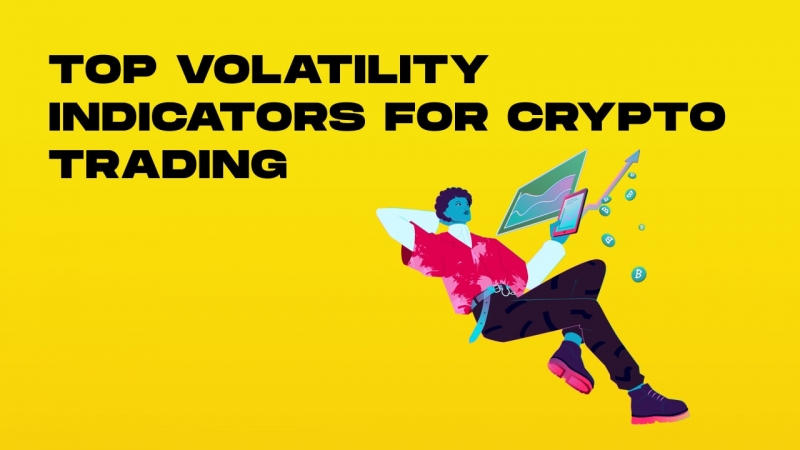With tools like automated crypto trading and algorithmic trading becoming increasingly important for any retail crypto trader, getting by without using advanced indicators is quite challenging.
The main narrative that sceptics align with is that cryptocurrencies are inherently speculative assets that should not be approached closer than a mile by conservative investors. While it is true that using crypto can be somewhat dangerous for very traditional investors, retail traders and new-age capital holders greatly benefit from investing in these financial assets.
How do they do it? The vast majority of successful crypto traders use various forms of technical analysis and incorporate some of the best indicators for crypto trading in their systems to ensure that they optimize profits and risks.
What are the most profitable indicators in crypto?
Defining profitability for any given indicator is not something feasible since the performance of tools greatly depends on the competence of their users. The most pivotal factor determining the general outcome of investments is the ability of an investor to balance a portfolio and create a robust collection of assets capable of bringing in profits under different market circumstances.
However, some indicators are more popular than others. There are many reasons why certain volatility indicators gain popularity among retail traders:
- Ease of use. Rarely, a retail trader understands the intricacies of the financial world to the fullest extent. Instruments designed to provide the most essential information in the most appealing way usually become more prevalent.
- Meaningfulness of data. Most technical indicators use only one or, rarer, two types of information: price action and volumes. The best volatility indicators simply interpret the data better and allow their users to see the current situation in the market with precision and cleanness.
- Representation on platforms. The most obvious reason for the popularity of any given indicator is its availability on various terminals and analytical platforms. Many brokers and exchanges also have platform-native terminals that may have some indicators over others.
To reach optimal profitability, it is a good idea to employ a wide range of analytical tools, but also master several different types of crypto indicators (volatility, trend, momentum, etc.). If you master them, you will be able to build sophisticated trading systems that generate reliable signals and can outperform the market.
What is a crypto volatility indicator?
Traditional financial markets working with bonds and stocks have their own way to determine the current level and the implied volatility. The former is the deviation of the current price from the 30-day mean while the latter is the extrapolation of the metric. Implied volatility can be calculated using other approaches and, depending on the chosen method, may differ drastically.
The standard deviation indicator is one of the most commonly used tools allowing retail traders to avoid periods of uncertainty and identify moments for an optimal entry.
The cryptocurrency volatility index (CVI) is the same measure for the crypto market. It is a great tool that can help investors avoid risky investments and purchase assets at opportune moments. A crypto volatility tracker is a tool that uses CVI to show a different perspective on historical volatility and predict the amplitude of price action changes in the nearest future.
What is the best indicator of volatility for crypto?
The cryptocurrency market may seem drastically different from other financial markets, but it operates just like any other speculative environment. Prices are driven by retail traders and institutional investors. The psychology of the crowd and the manipulative power of high-net worth individuals are on display in full power.
It means that whichever indicator performs well in other financial markets will do great in the crypto market. Let’s talk about the best volatility indicators!
Bollinger bands — a popular tool for measuring volatility
Used by thousands of retail traders, this indicator is designed to predict market volatility while plotting potential support and resistance levels. This tool analyzes the price action and determines how it will change over time assuming conditions won’t change dramatically in the nearest future.
How to use Bollinger Bands:
- The indicator has three lines. The middle one is a simple moving average while two accompanying lines are deviations from the SMA.
- Upper and lower levels can be used to forecast future resistance and support levels respectively.
- When the market approaches the forecasted support level, you should take a start looking for an opportunity to open a long position.
- When the market approaches the forecasted resistance level, you should look for a short position if other indicators align properly.
Average True Range Indicator
Delivering a good snapshot of any given moment in the market history is a great feature for a technical indicator. It gives you a new angle to approach the uncertainty and identify good moments to start trading. ATR is a highly specialized volatility ratio indicator that shows the degree to which prices change over a certain period.
The biggest advantage of ATR is that you can easily identify moments when it is too risky to open any market position and avoid dangerous times when it is best to simply stay away from trading. The simple moving average representing the change of true range is also a great way to confirm signals from other tools.
Parabolic SAR indicator
Stop and Reversal indicator is one of the best tools that retail traders may use to identify a good moment to capitalize on changing trends or massive price retracements. While it is not a “true” volatility indicator, it is capable of predicting upcoming price action movements and signalling when the market is reaching a moment when it is ready to reverse the course regardless of the current volatility ratio.
SAR indicator should be used in conjunction with a variety of complementary tools including trend, volume, and other volatility indicators.
Cryptocurrency Volatility Index
While CVI is not an indicator, it is still an incredible tool for any crypto retail trader. The formula used to calculate the value of CVI at any given moment is the same that VIX (Volatility Index) creators use to analyze hundreds of stocks. CVI takes into account price action across several hundred tokens traded on the biggest centralized exchanges.
Price changes are denominated in percentile points and averaged across the market. The math behind CVI is quite complex and requires numerous calculations. End users do not need to do anything, they just look at the index and see the strength of volatility and its current dynamic.
It is necessary to include CVI tracking in your investment strategy to avoid periods of high volatility when even the most consistent strategies struggle to perform according to expectations.
Keltner Channel Indicator
This particular tool is quite useful for people who want to make forecasts regarding support and resistance levels. It works similarly to Bollinger Bands. In fact, you can use the same general approach to using this indicator. It uses EMA as its reference and two bands representing upper and lower limits of price action changes.
Keltner shows when the trend is losing power by accounting for rapid volatility changes. When lines diverge, it means that the market is closing a period when traders are indecisive and that a reversal can happen very soon.
Just like in case with other examples in our list, it is wise to use this particular tool together with other elements of your technical analysis strategy. Keltner can help you confirm a signal, but it does not provide reliable results on its own.
Building a strong trading system
When it comes to creating a reliable trading system that can be used in a myriad of ways, the biggest focus is consistency. You should reach a certain equilibrium when your average good returns across a certain period. The easiest way to create a system like that is by combining multiple analytical instruments including the best volatility indicators and momentum indicators.
Since you can deploy these strategies on platforms like TradingView, it is relatively easy to automate them. You don’t necessarily need to use automation to trade, but it is one of the best methods to test the consistency of any given method.
For example, WunderTrading offers an automation package that includes the backtesting feature allowing you to test any strategy deployed on TradingView. The historical data is not the ideal representation of the collective behaviour of all market participants in the future, but it is still a great source of insight for experienced investors.
Bot users must use the best volatility indicator!
Automation is a tool used by over 40% of all retail traders in the crypto market. Bots can be useful to experienced investors, managers of diversified portfolios, and even newcomers to the industry. Millions of users try to automate their trading routines with many succeeding in creating a consistently performing automated trading system capable of generating profits with impressive reliability.
However, even power users with rich experience and vast knowledge about the market may struggle to reach profitability if they keep running their bots even during unfavourable periods.
Moments when bots may not perform as intended:
- High volatility may cause indicators to generate false positives.
- Increases in volume can be dangerous for certain market positions.
- The fluctuations in the market happen due to unforeseen and unpreventable events.
For example, the market may sway in a certain direction even when you have a perfect alignment of indicators because something happened that was out of your control. A sudden news story about upcoming regulations, technological breakthroughs, fraudulent activities, and any other relevant issue can create too much uncertainty for an automated system to deal with.
While you cannot predict drastic price movements caused by something that was completely unpredictable in the first place, it is possible to avoid risks related to volatility. You need to use indicators to identify moments when implied volatility is too high for your algorithm to work.
Contemporary uses for the best volatility indicators
A typical cryptocurrency portfolio may contain hundreds of different assets. Experienced retail traders try automating purchases and even some advanced trading endeavors. However, it is important to avoid trading during periods of extreme volatility or reduce your exposure to risks associated with high volatility when dealing with specific digital assets.
For example, you may have a sizeable investment in DOGE or other speculative assets that may be affected by high market volatility more than something like Bitcoin. It means that you should halt trading DOGE during these periods.
Volatility indicators can be useful when trying to forecast price action, but they are also great at warning retail traders about upcoming storms in the market. Use them in conjunction with various technical analysis tools to optimize the performance of your portfolio!
The main takeaway
Contemporary retail traders should focus on building consistently performing trading systems. It is close to impossible to do so without employing the whole range of available instruments including such insightful tools as volatility indicators!
























